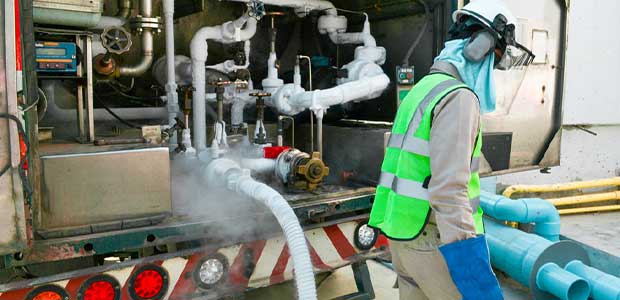
Recent Accident is a Stark Reminder of the Dangers of Nitrogen in the Workplace
It is important to understand the dangers of nitrogen in the workplace and the safety measures that should be implemented to avoid injury.
- By Mark Heuchert
- Jun 16, 2021
In January, six people were killed and another 11 were treated for injuries after a nitrogen line ruptured at a poultry processing plant in Gainesville, Georgia. The six who died were all employees of the company – the 11 injured, some critically, included employees as well as firefighters and first responders on the scene of the hazmat situation.
Liquid nitrogen, which is often used for refrigeration at food processing plants and at medical facilities that house cryogenic freezers, is not considered toxic. In fact, nitrogen makes up 78 percent of the air we breathe. How can it become so lethal?
When liquid nitrogen is released into the air, it vaporizes and expands 695 times in volume to displace oxygen. If a large enough volume of liquid nitrogen is released, say from a leak, or if a space is poorly ventilated, oxygen levels in the air can dip below 19.5 percent, presenting a risk of oxygen deficiency. Because the vaporized nitrogen offers no warning signs – such as a colored haze or an acrid odor – those exposed can quickly suffer asphyxiation without ever recognizing they are in trouble. If nitrogen levels are especially high and oxygen deficiency is extreme, death can result.
According to OSHA, between 2012 and 2020, 14 American workers died from asphyxiation related to nitrogen in 12 different workplace accidents. Avoiding these accidents is a clear challenge to the industry, and one that must be taken seriously - especially considering that these incidents are mostly preventable.
First and foremost, in areas where nitrogen is used, and especially in and around confined spaces, sufficient ventilation is required to prevent oxygen deficiency. Experts suggest that at least four to six changes of fresh air per hour should be provided, depending on space size, the quantity of nitrogen being used and the overall area layout.
Because nitrogen lacks properties that warn of its presence (i.e., color or odor), an oxygen monitoring system should be installed in any indoor area where nitrogen is used or stored. There are several varieties of systems, including: personal monitors, portable handheld monitors and stationary air quality monitors.
A stationary system is a self-contained gas detection system designed to continuously monitor the oxygen concentration in ambient air from a range of 0-25 percent volume. Some include a remote sensor option that allows placing the sensor inside of a room and the stationary system outside to let people know it is safe to enter the room. A horn and/or strobe will activate once the oxygen concentration falls below the OSHA permissible exposure limit of 19.5 percent oxygen.
Personal monitoring devices enable workers to receive precise and immediate ambient air quality readings, so even if there are no recognizable warning signs, they can be alerted to danger. Personal monitors can be especially beneficial in rescue situations where someone may be called upon to enter a hazardous space to extract a worker in danger. These devices can be a very reliable and precise instrument that measures carbon monoxide, hydrogen sulfide, sulfur dioxide or oxygen quickly and precisely. Quick sensor response times and a replaceable battery also help to ensure safety.
The recent accident in Georgia is a stark reminder of the potential danger nitrogen can present in the workplace. Understandably, many safety-minded facilities around the U.S. and Canada are re-evaluating their practices and procedures to ensure they protect their workers. Proper ventilation is always first and foremost, but basic precautionary measures should also include oxygen monitoring systems.